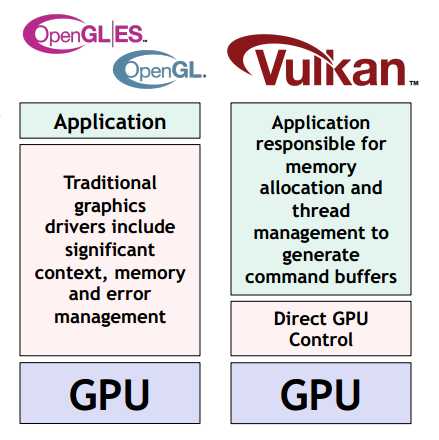标签:imp javascrip parse bar complete margin play test k sum
?
Learning Modern OpenGL
?
A little guide about modern OpenGL and why it gives us so much value.


Shaders + Cube Env Map + Phong Lighting
Introduction
Ok... so you want to learn modern OpenGL. Great! But what does it really mean and what options are available? Do you have to buy expensive books about this technology, or maybe some basic online tutorials are enough?
In this article, I will try to answer some of the questions above and create a guide to a wonderful world of graphics programming using OpenGL.
Let us start!
The plan:
The first question I would like to answer is why there is a term called ‘modern OpenGL‘. Is there ‘old OpenGL ‘ as well?
Basically modern means "using programmable graphics pipeline", old means "fixed pipeline".
What is the difference? This is quite a broad topic, but for now I think it is good to know that fixed pipeline was like a black box. You inserted the vertex data in the front (at the input) and you got triangles written to the framebuffer (screen) at the end. You could of course tweak this box to your needs but at some point, it was not enough.
Programmable pipeline?is more like a white, transparent box where not only you put input data and wait for the result, but you can insert/change internal mechanisms as well. There is a general form of the pipeline, but a lot of parts are fully controlled by you - thanks to?shaders.
Shader is a little program that can compute various things and is run on the GPU. It can transform vertices, calculate color of fragments, delete or add more triangles and even more.
To illustrate this idea, I prepared two images:


Idea of a fixed graphics pipeline


Idea of a programmable graphics pipeline
Although the images above are very very simplified, they show that programmable pipeline is much more flexible and more control is in the hands of a programmer. Thanks to shaders, one can create a lot of graphics effects that was not possible with fixed pipeline.
Currently, with new releases of graphics API (like OpenGL or DirectX), we get more and more control over the GPU. If we look at modern games‘ engines, we will see that great parts of it are run completely on GPU. Thus is it important to learn the modern way.
Version? | Important changes? |
1.1 - March 1997? | Fixed pipeline! Note that the version 1.0 was released in 1992. The latest 1.x version is 1.5 from July 2003 (includes, for instance, VBO and occlusion queries).? |
2.0 - September 2004? | OpenGL Shading Language officially in the standard. Pixel buffer objects, sRGB. Version 2.1 (July 2006) matches DirectX 9.0c. OpenGL 2.0/2.1 is a safe point for targeting wide range of older devices (and still one can use shaders)? |
3.0 - August 2008? | Deprecated features list, Frame buffer objects, floating point textures, transform feedback, Core Profile, Geometry shaders, synchronization objects. OpenGL 3.3 (March 2010) can be compared to DX 10? |
4.0 - March 2010? | Tesselation shaders, draw indirect, ES2 compatibility, program binaries, separate shaders objects, Compute shaders. OpenGL 4.5 (August 2014) can be compared to DX 11.1 or even supersede it. |
I suggest the following topics for the beginning:
Then:
I left the second list unfinished on purpose. By the time you reach these points, you will definitely have a more clarified perspective on what you want to achieve and how to get where you want.
OpenGL Superbible: Comprehensive Tutorial and Reference (7th Edition)
When we understand our motivation, we are able to start learning. Sometimes it is quite a hard task though! There are plenty of available resources so a person can be lost and lose his/her initial passion.
OpenGL Superbible?became a standard book for learning OpenGL, and actually I cannot suggest anything different that that. Going back into my history, this was my first book about graphics programming. At that time, I had the first edition! Now we have the 7th (released on August 2015)
The Structure
The book gives all the information needed to start and even become quite proficient with OpenGL. The book is both for beginners but also for people very familiar with graphics APIs. as you can see, there are basic chapters, as well as very advanced topics. The writing style is great and no one should have problems with understanding it. The size is around 1000 pages. I guarantee that you‘ll be often returning to the content of this amazing book.
It is also worth mentioning that there is a lot of online content that can help you. One of the best available tutorials about modern OpenGL (3.3+) comes from Jason L. McKesson in?his arcsynthesis tutorials. Another good site is?open.gl?and?lighthouse3d core?and also?learnopengl.com.
Additionally, if you want to get even more graphics theory, you can take a look at those two ‘core‘ books:


Normal Mapping with GLSL
When you have the base and know how to use OpenGL, then you can choose in what area you want to go.
Some time ago, a person would usually go into rendering engine development - meaning more graphics effects. But today, we also have web and mobile apps so your focus can be different.
For ‘normal‘ graphics development, I suggest investing some money in two books that appeared recently - two cookbooks actually!
One of them is OpenGL 4 Shading Language Cookbook and the second one is OpenGL Development Cookbook.


OpenGL 4 Shading Language Cookbook - Second Edition
The idea of programming recipes was quite new to me, but I liked it from the beginning. In both mentioned books, there are lots of different sub-chapters that could be read almost in any order. We usually start with some simpler examples and move towards advanced ones, but still the structure is more loose as with ‘common‘ programming books.
OpenGL 4 Shading Language?is a great resource for learning almost the newest version of OpenGL -?4.3. It was refreshed recently and the content got even better. We have the following topics covered:
Those topics create a very decent base for any graphics programmer.


The second book -?OpenGL Development Cookbook?- has a similar style as the first one. It uses OpenGL 3.3 - so a bit older, but still valid. The book describes similar areas: introduction to OpenGL, GLSL, lighting, shadows... but examples are different than in the first book. You can compare examples and get some new perspective and coding techniques.
What is important, OpenGL Development Cookbook adds some other valuable chapters to our graphics knowledge bag:
All in all, you could treat both of those books as one pack. BTW: you can read my full review of OpenGL Development Cookbook in a?separate codeproject article.
Those two cookbooks have great value for me because they fill a niche among graphics programming books. At one side, we have introductory level books like SuberBible, on the other side there are more ‘hardcore‘ books like?GPU Pro?or?ShaderX?(and recent?OpenGL Insights). The cookbooks fall in the middle and are great resources for anyone with some good OpenGL knowledge who wants to go further.
As you have probably noticed, all of the mentioned books and websites used C++ as a language for code samples. C++ seems to be the most popular choice in this area. But if you know other languages, you are not doomed!
OpenGL is only API and there are lots of different language?bindings.
So:
It is worth noticing that no matter what programming language you chose, the graphics theory is the same. So if you know how to make a graphics effect in one language, then it should be relatively easy to do it similarly in some different language.
Currently (December 2014, latest drivers) most of recent desktop GPUs will support OpenGL 4.* or at least 3.*.
Below you can find a quick summary:
GPU? | Supported OpenGL Version |
NVidia GeForce 6 and 7 Series? | OpenGL 2.1? |
Tesla: NVidia GeForce 8, 9 ?100, 200, 300 Series? | OpenGL 3.3? |
Fermi: NVidia GeForce 400, 500 Series? | OpenGL 4.5? |
Kepler and Maxwell: NVidia GeForce 600, 700 800M, 900 Series? | OpenGL 4.5 |
AMD Radeon R300, R400, R500, | OpenGL 2.0? |
AMD Radeon R600 (HD2000, HD3000), R700 (HD4000)? | OpenGL 3.3? |
AMD Evergreen (HD5000)? | OpenGL 4.5? |
AMD * Islands (HD6000, HD7000 and HD8000)? | OpenGL 4.5? |
AMD Volcanic Islands (R7 and R9) and newer? | OpenGL 4.5? |
Intel(R) HD Graphics 2000/3000 (Sandy Bridge) | OpenGL 3.1? |
Intel(R) HD Graphics 2500/4000 (Ivy Bridge)? | OpenGL 4.0? |
Intel(R) HD Graphics 4400/4600/5000 (Haswell)? | OpenGL 4.3? |
If you want some more details take a look at this wonderful?OpenGL Hardware Database
Some time ago (at GDC 2014) there was a great presentation delivered about achieving even more performance with OpenGL. This whole set of ideas is called?AZDO?- "Approaching Zero Driver Overhead". As the name suggests this approach focuses on minimalizm the driver work. Very often gpu has a lot of available power, but it has to wait for the driver to finish some work.
Short summary of techniques:
AZDO is complicated but powerful. It can unlock a lot of power in your engine. This is also a good starting point for new graphics API like do DirectX 12 or Vulkan - in which the driver will be minimalistic and all the work will be dependent on clients(programmers).
OpenGL Next and Vulkan?
Announced at?GDC 2015?in San Francisco, and then officially published on February 16th 2016 (Khronos), Vulkan is a new API that should unlock even more power from the hardware.
From the official Khronos presentation:

As you can see with Vulkan we‘ll get more direct control over GPU/CPU. The driver work is minimized. Of course, Vulkan is multiplatform: from high end PC to low end mobile devices (Except for Mac OS). Theoretically, we should see more framerates, more object on the screen and better hardware utilization.
The flexibility and performance comes at some cost though. You get the control, but most of the things the driver did (synchronization, buffere management, shader management, multithreading, command buffers) will have to be handled by your engine. Large engines do such management anyway, thus they should benefit the most. But if you‘re doing a simple simulation, with basic rendering that can hurt. Even simple Vulkan demos contains hundreds of lines of code just for some basic stuff.
While not for everyone, Vulkan brings a lot of promises. It‘s completely new, so there is no overhead of the legacy functionality. If you take graphics programming seriously, please check out code samples and Vulkan examples.


Water on GPU + Normal Mapping Source:?Simple Water Simulation
In this article, I tried to give you enough resources to start and make good progress with graphics programming. OpenGL is a very popular technology right now. A lot of new possibilities will be available for anyone with decent graphics API experience. You can not only make AAA game engines, but also move into web or mobile development. And with Vulkan there‘s even more (low level) fun!
Have a nice journey with Modern OpenGL!
You can also see more about OpenGL at Bartek‘s blog:?http://www.bfilipek.com/.
?
?
From: https://www.codeproject.com/Articles/771225/Learning-Modern-OpenGL
标签:imp javascrip parse bar complete margin play test k sum
原文地址:http://www.cnblogs.com/time-is-life/p/6370853.html